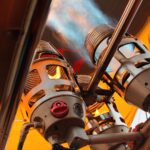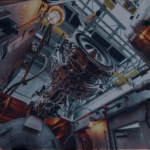
Combustion et performances énergétiques
Mots clés : combustion, performances énergétiques, calculs multi-physiques, modèles statistiques, turbulence, radiation, maillage non structuré, HPC, dimensionnement thermomécanique.
Enjeux et objectifs
La combustion représente 85% de l’énergie primaire dans le monde
Elle caractérise une réaction chimique nécessaire pour les systèmes de motorisation automobile et aéronautique, principale lorsqu’il s’agit de transformer les matériaux, produire de l’électricité et chauffer nos lieux d’habitation.
En contrepartie, ce phénomène physique constitue une source de polluant atmosphérique et d’émissions de CO2 non négligeable.
Il convient donc d’appréhender de plus en plus précisément les phénomènes de combustion afin de réduire la consommation énergétique des équipements et conduire à la réduction des gaz à effet de serre.
Notre bureau d’études investigue depuis de nombreuses années ces problématiques afin de développer des méthodes de simulations numériques prédictives. Il est a noter qu’en trente années les émissions polluantes (suies, oxydes d’azote, …) des moteurs associés à cette typologie de phénomène ont été divisées par 1 000.
Les simulations numériques permettent de calculer les quantités d’espèces polluantes (CO2, CO, Nox, Suies) produites lors de la combustion mais aussi de prévoir leur répartition dans un système afin d’anticiper des zones de concentration.
Les modèles utilisés vont essentiellement dépendre du :
Ξ Type de flamme : selon si carburants et comburants sont au préalable mélangés ou non (flamme de prémélange ou flamme de diffusion), de sa turbulence (flamme laminaire ou non)
Ξ Niveau de précision : à savoir les physiques nécessaires (radiation, CHT, …) et le niveau de puissance des machines de calcul (calcul transitoire à plusieurs millions d’éléments, …).
L’approche multi-physique peut donc rapidement devenir une nécessité, non seulement pour appréhender correctement la combustion mais aussi tous ses phénomènes annexes. Cela permet à la fois de connaitre la présence et la quantité des espèces chimiques (gaz imbrulés, polluants) ainsi que la puissance dégagée par la combustion et les champs de températures qui en découle.
D’autres problématiques peuvent être étudiées simultanément, souvent d’ordre géométrique, comme les retours de flamme (pour les flammes de prémélange) et la stabilisation des flammes grâce à un effet de swirl. En effet, ces phénomènes sont étroitement liés à la bonne combustion ou non des réactifs.

Prestations CIMES
Ξ Modélisation éléments finis du phénomène de combustion par modèle PaSR
Ξ Modélisation statistique de la combustion par modèle PDF
Ξ Evaluation des champs de température, des points chauds, des températures de parois
Ξ Prédictions des puissance dégagées, des gaz imbrulés, des espèces polluantes (CO2, CO, Nox, Suies)
Ξ Analyse des zones de recirculation
Ξ Etude des retours de flamme (flamme de prémélange)
Ξ Simulations multiphysiques via HPC interne (combustion, turbulences, radiation, CHT, suivi des espèces chimiques)
Ξ Amélioration des performances énergétiques







